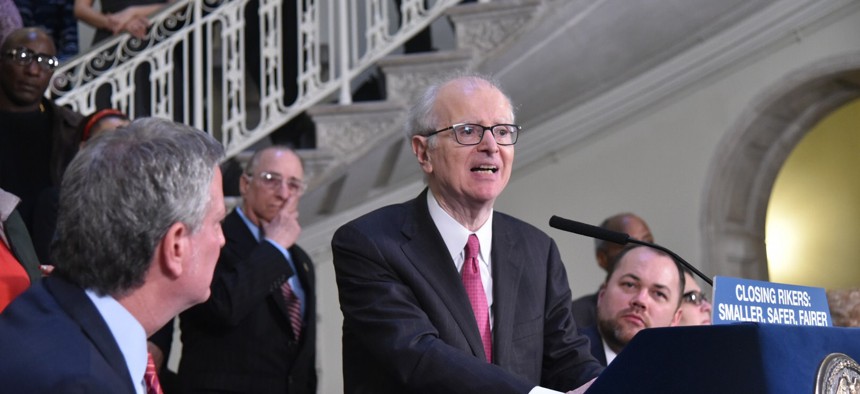New York City
Lippman Commission calls for expanding supervised release
Bail reform stalled in the state Legislature this year despite a push from the grassroots to the governor, but the Lippman criminal justice commission is releasing a report saying that New York City doesn’t have to wait until next year to keep more New Yorkers out of jail.

Former Judge Jonathan Lippman gives remarks during a press conference. John McCarten/New York City Council
Bail reform stalled in the state Legislature this year despite a push from the grassroots to the governor, but a criminal justice commission is releasing a report saying that New York City doesn’t have to wait until next year to keep more New Yorkers out of jail.
One key way that New York City could move forward without state legislation is to expand its supervised release program, according to a report that the Independent Commission on New York City Criminal Justice and Incarceration Reform is publishing on Tuesday.
Under supervised release, people who are arrested and charged are allowed to await trial at home rather than in jail. Unlike with bail, they don’t have to pay for the privilege of staying out of jail. Instead, defendants are assigned a social worker who checks in intermittently before trial.
The Lippman Commission, as the group is commonly known, was convened by then-New York City Council Speaker Melissa Mark-Viverito in 2016 to study reforms that could lead to the closing of the Rikers Island jail complex. The commission, which released a blueprint in 2017, has continued to meet quarterly. This latest report is the first of many planned supplemental reports, following up on specific recommendations from the initial report.
As left-leaning voters seem to be increasingly energized by criminal justice reforms, Gov. Andrew Cuomo backed the elimination of cash bail for minor crimes this year. But the proposals couldn’t pass the Republican-controlled state Senate.
The commission’s chairman told City & State that the city can take action on its own. “There’s no reason to wait for the Legislature,” said Jonathan Lippman, the state’s former chief judge. “There are things that could be done without legislation, and supervised release is at the top of the list.”
New York City Mayor Bill de Blasio expanded the fledgling supervised release program citywide in 2016 to reduce reliance on bail. But two years later, the number of eligible defendants is limited, and judges still set bail for more than one-fifth of these cases.
The report, titled “Beyond Bail or Nothing: The Case for Expanding Supervised Release,” argues that expanding the supervised release program could reduce the average daily jail population in New York City by nearly 2,000 people. This, combined with other fixes, would bring the jail population to below 5,000 – the target set by the de Blasio administration as to when all inmates could be moved off of Rikers Island.
Lippman said the report is intended for judges, defense attorneys and other players in the criminal justice system who need to realize there are other options beyond cash bail. “We’re so conditioned to the bail system I think we lose the forest for the trees,” he said.
Currently, the city only allows judges to grant supervised release to defendants accused of certain nonviolent crimes, among other criteria. The Lippman Commission recommends expanding the eligibility, even, in some cases, to defendants accused of violent felonies. It also calls on the city to significantly increase funding for social workers who supervise the defendants. The report doesn’t estimate a cost, but Lippman said the program would more than pay for itself, given the high cost of incarcerating defendants awaiting trial.
Lippman acknowledged the political difficulty of allowing more New Yorkers accused of crimes to live in the community, but said this was a reasonable plan. “You can’t be intimidated by the tough on crime/soft on crime continuum,” he said. “You have to be smart on crime.”
NEXT STORY: Better ways to get to LaGuardia Airport

